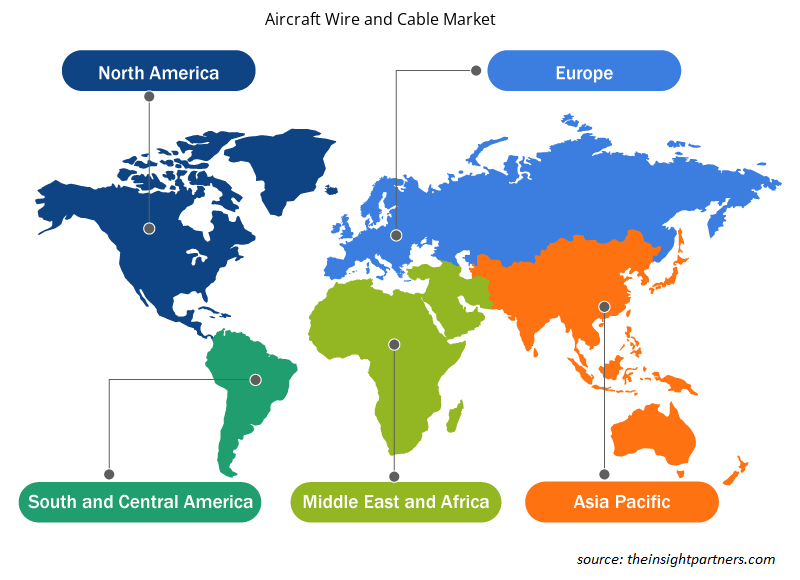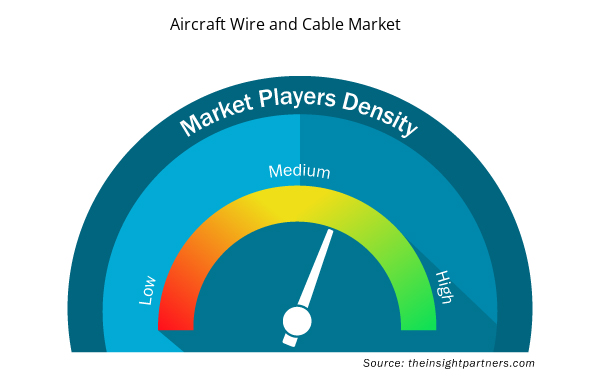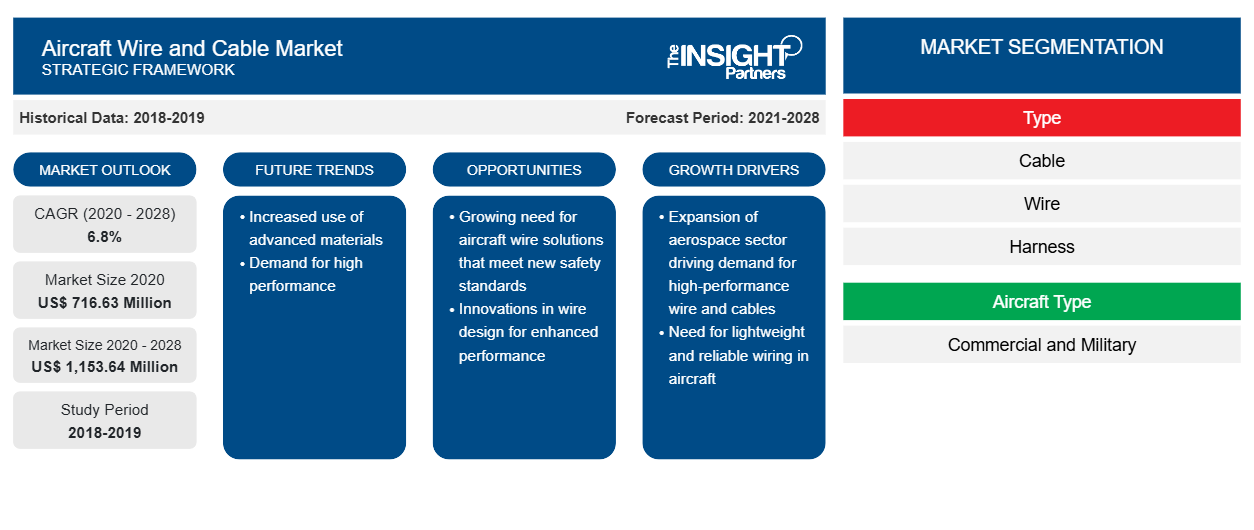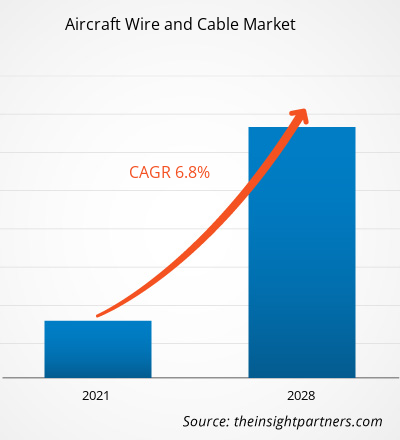[Forschungsbericht] Der globale Markt für Flugzeugdrähte und -kabel wurde im Jahr 2020 auf 716,63 Millionen US-Dollar geschätzt und soll bis 2028 1.153,64 Millionen US-Dollar erreichen; im Prognosezeitraum von 2021 bis 2028 wird ein durchschnittliches jährliches Wachstum von 6,8 % erwartet.
Der Markt für Flugzeugdrähte und -kabel ist grob in fünf große Regionen unterteilt: Nordamerika, Europa, APAC, MEA und SAM. In Bezug auf den Marktanteil dominierte die Region Nordamerika den Markt für Flugzeugdrähte und -kabel im Jahr 2020. In der Region Nordamerika sind multinationale Unternehmen vertreten, die im Geschäft mit der Bereitstellung von Flugzeugdrähten und -kabeln tätig sind, was sie im Jahr 2020 zu einer führenden und dominierenden Region des Marktes für Flugzeugdrähte und -kabel macht. Faktoren wie die Verfügbarkeit technologischer Kapazitäten, Infrastrukturunterstützung, F&E und technisches Fachpersonal haben unter anderem zur deutlichen Konsolidierung des Marktanteils für Flugzeugdrähte und -kabel in Nordamerika beigetragen.
Auswirkungen der COVID-19-Pandemie auf den Markt für Flugzeugdrähte und -kabel
Laut dem jüngsten Lagebericht der Weltgesundheitsorganisation (WHO) sind die USA, Indien, Brasilien, Russland, Großbritannien, Frankreich, Spanien und Italien einige der am schlimmsten vom COVID-19-Ausbruch betroffenen Länder. Der Ausbruch begann im Dezember 2019 in Wuhan (China) und hat sich seitdem rasant über den Globus ausgebreitet. Die COVID-19-Krise betrifft die Industrien weltweit und die Weltwirtschaft war 2020 und wahrscheinlich auch 2021 negativ betroffen. Die Pandemie hat Unternehmen und Zulieferer von Flugzeugdrähten und -kabeln auf der ganzen Welt in Schwierigkeiten gebracht. Die Marktteilnehmer erlebten Betriebsstörungen, und dies wird wahrscheinlich bis Mitte 2021 Folgen haben. Bis zum Ausbruch von COVID-19 verzeichnete die Luft- und Raumfahrtindustrie trotz enormer Rückstände bei den Flugzeugherstellern ein erhebliches Wachstum in Bezug auf Produktion und Dienstleistungen; die globale Luftfahrtindustrie erlebte einen deutlichen Anstieg der Passagierzahlen, einen Anstieg der Flugzeugbeschaffung (sowohl kommerziell als auch militärisch) sowie ein steigendes Wachstum bei MRO-Aktivitäten.
Passen Sie diesen Bericht Ihren Anforderungen an
Sie erhalten kostenlos individuelle Anpassungen an jedem Bericht, einschließlich Teilen dieses Berichts oder einer Analyse auf Länderebene, eines Excel-Datenpakets sowie tolle Angebote und Rabatte für Start-ups und Universitäten.
- Holen Sie sich die wichtigsten Markttrends aus diesem Bericht.Dieses KOSTENLOSE Beispiel umfasst eine Datenanalyse von Markttrends bis hin zu Schätzungen und Prognosen.
Markteinblick – Markt für Flugzeugdrähte und -kabel.
Die rasante Expansion des Luftfahrtsektors weltweit und die zunehmende Einführung fortschrittlicher Technologien für den reibungslosen Betrieb von Flugzeugen unterstützen das Wachstum des Marktes erheblich. Darüber hinaus zählen die Präsenz starker Flugzeughersteller wie Boeing und Airbus sowie steigende verfügbare Einkommen in Entwicklungsländern zu den Faktoren, die die Nachfrage nach diesen Flugzeugdrähten und -kabeln antreiben.
Die steigenden Verteidigungsausgaben in bedeutenden Volkswirtschaften wie den USA, China, Indien, Russland und Saudi-Arabien werden voraussichtlich den Markt für Flugzeugdrähte und -kabel in den kommenden Jahren ankurbeln. Darüber hinaus treiben die zunehmenden technologischen Entwicklungen, die wachsenden Investitionen in Forschung und Entwicklung (F&E) durch Flugzeughersteller (OEMs) und die steigende Nachfrage nach Lufttransport das Wachstum des Luft- und Raumfahrt- und Verteidigungssektors voran, was wiederum das Wachstum des Marktes für Flugzeugdrähte und -kabel vorantreibt.
Einblicke in das Typsegment
Basierend auf dem Typ ist das Drahtsegment das Segment mit den meisten Anforderungen auf dem Markt und es wird erwartet, dass dasselbe Segment den Markt in Bezug auf den Marktanteil dominieren wird. Da jedoch Kabel zunehmend für verschiedene Funktionen eingesetzt werden, wird erwartet, dass das Kabelsegment das am schnellsten wachsende Segment auf dem Markt für Flugzeugdrähte und -kabel sein wird.
Einblicke in das Flugzeugtypsegment
Basierend auf Flugzeugtypen ist der globale Markt für Flugzeugdrähte und -kabel in kommerzielle und militärische unterteilt. Aufgrund des bemerkenswerten Wachstums der Zahl der ausgelieferten Verkehrsflugzeuge wird erwartet, dass der Verkehrsflugzeugtyp im Prognosezeitraum den Markt in Bezug auf den Marktanteil dominieren wird.
Einblicke in das Passform-Segment
Basierend auf der Passformart wird der globale Markt für Flugzeugdrähte und -kabel vom Segment der Leitungspassung dominiert, das im Jahr 2020 den größten Marktanteil hatte und seine dominierende Stellung auf dem globalen Markt für Flugzeugdrähte und -kabel im Prognosezeitraum voraussichtlich beibehalten wird.
Einblicke in Anwendungssegmente
Basierend auf der Anwendung wird der Markt für Flugzeugdrähte und -kabel vom Segment Energieübertragung dominiert, das im Jahr 2020 den größten Marktanteil hatte und seine Dominanz im Prognosezeitraum auf dem globalen Markt für Flugzeugdrähte und -kabel voraussichtlich beibehalten wird.
Die Marktteilnehmer konzentrieren sich auf Produktinnovationen und -entwicklungen, indem sie fortschrittliche Technologien und Funktionen in ihre Produkte integrieren, um mit der Konkurrenz mithalten zu können.
- Im Jahr 2020 erklärte Harbour Industries LLC, dass es als Hersteller für mehrere verlustarme Koaxial- und Hochgeschwindigkeitsdatenkabel zugelassen sei, die in Lockheed Martins Kampfflugzeugen F-35 Lighting II der 5. Generation verwendet werden.
- Im Jahr 2020 stellte TE Connectivity (TE) sein neues Mini-ETH-Single-Pair-Ethernet-System für Verkehrsflugzeuge vor.
- Im Jahr 2019 erwarb Carlisle Companies Incorporated 100 % der Anteile an Draka Fileca SAS von Prysmian SpA
Umfang des Marktberichts über Drähte und Kabel für Flugzeuge
Regionale Einblicke in den Markt für Flugzeugdrähte und -kabel
Die regionalen Trends und Faktoren, die den Markt für Flugzeugdrähte und -kabel während des gesamten Prognosezeitraums beeinflussen, wurden von den Analysten von Insight Partners ausführlich erläutert. In diesem Abschnitt werden auch die Marktsegmente und die Geografie für Flugzeugdrähte und -kabel in Nordamerika, Europa, im asiatisch-pazifischen Raum, im Nahen Osten und Afrika sowie in Süd- und Mittelamerika erörtert.

- Erhalten Sie regionale Daten zum Markt für Flugzeugdrähte und -kabel
Umfang des Marktberichts über Drähte und Kabel für Flugzeuge
| Berichtsattribut | Details |
|---|---|
| Marktgröße im Jahr 2020 | 716,63 Millionen US-Dollar |
| Marktgröße bis 2028 | 1.153,64 Millionen US-Dollar |
| Globale CAGR (2020 - 2028) | 6,8 % |
| Historische Daten | 2018-2019 |
| Prognosezeitraum | 2021-2028 |
| Abgedeckte Segmente | Nach Typ
|
| Abgedeckte Regionen und Länder | Nordamerika
|
| Marktführer und wichtige Unternehmensprofile |
|
Marktteilnehmerdichte: Der Einfluss auf die Geschäftsdynamik
Der Markt für Flugzeugdrähte und -kabel wächst rasant. Dies wird durch die steigende Nachfrage der Endnutzer aufgrund von Faktoren wie sich entwickelnden Verbraucherpräferenzen, technologischen Fortschritten und einem größeren Bewusstsein für die Vorteile des Produkts vorangetrieben. Mit der steigenden Nachfrage erweitern Unternehmen ihr Angebot, entwickeln Innovationen, um die Bedürfnisse der Verbraucher zu erfüllen, und nutzen neue Trends, was das Marktwachstum weiter ankurbelt.
Die Marktteilnehmerdichte bezieht sich auf die Verteilung der Firmen oder Unternehmen, die in einem bestimmten Markt oder einer bestimmten Branche tätig sind. Sie gibt an, wie viele Wettbewerber (Marktteilnehmer) in einem bestimmten Marktraum im Verhältnis zu seiner Größe oder seinem gesamten Marktwert präsent sind.
Die wichtigsten auf dem Markt für Drähte und Kabel für die Luftfahrt tätigen Unternehmen sind:
- Axon Enterprise, Inc.
- Harbour Industries, LLC
- Draka
- Glenair, Inc.
- HUBER+SUHNER
Haftungsausschluss : Die oben aufgeführten Unternehmen sind nicht in einer bestimmten Reihenfolge aufgeführt.

- Überblick über die wichtigsten Akteure auf dem Markt für Flugzeugdrähte und -kabel
Der globale Markt für Drähte und Kabel für die Flugzeugindustrie ist wie folgt segmentiert:
Markt für Flugzeugdrähte und -kabel – nach Typ
- Kabel
- Draht
- Geschirr
Markt für Flugzeugdrähte und -kabel – nach Flugzeugtyp
- Kommerziell
- Militär
Markt für Flugzeugdrähte und -kabel – nach Passformtyp
- Linienanpassung
- Nachrüstung
Markt für Flugzeugdrähte und -kabel – nach Anwendung
- Kraftübertragung
- Datenübertragung
- Flugsteuerungssystem
- Avionik
- Beleuchtung
Markt für Flugzeugdrähte und -kabel – nach Regionen
Nordamerika
- UNS
- Kanada
- Mexiko
Europa
- Frankreich
- Deutschland
- Italien
- Vereinigtes Königreich
- Russland
- Restliches Europa
Asien-Pazifik (APAC)
- China
- Indien
- Südkorea
- Japan
- Australien
- Restlicher Asien-Pazifik-Raum
Naher Osten und Afrika (MEA)
- Südafrika
- Saudi-Arabien
- Vereinigte Arabische Emirate
- Rest von MEA
Südamerika (SAM)
- Brasilien
- Argentinien
- Rest von SAM
Markt für Flugzeugdrähte und -kabel – Firmenprofile
- Axon Enterprise, Inc.
- Harbour Industries, LLC
- Draka
- Glenair, Inc.
- HUBER+SUHNER
- Firma AE Petsche
- AMETEK Inc.
- Amphenol Corporation
- Carlisle Companies Incorporated
- Collins Aerospace, ein Unternehmen der Raytheon Technologies Corporation
- TE Connectivity Ltd.
- WL Gore and Associates, Inc.
- PIC-Leitungen und -Kabel
- Nexans
- Radiall
- Historische Analyse (2 Jahre), Basisjahr, Prognose (7 Jahre) mit CAGR
- PEST- und SWOT-Analyse
- Marktgröße Wert/Volumen – Global, Regional, Land
- Branche und Wettbewerbsumfeld
- Excel-Datensatz



Report Coverage
Revenue forecast, Company Analysis, Industry landscape, Growth factors, and Trends

Segment Covered
This text is related
to segments covered.

Regional Scope
North America, Europe, Asia Pacific, Middle East & Africa, South & Central America

Country Scope
This text is related
to country scope.
Häufig gestellte Fragen
Economic growth, increasing passengers, and growing aviation infrastructure spending across APAC are the factors driving the growth of the aircraft MRO industry in the region. According to the International Air Transport Association, the total number of new passengers would increase over the next 20 years. It would further increase the demand for MRO activities for upgrading the aircraft fleet. Rising middle-class travelers, especially in APAC: countries, such as India, China, and Singapore, is the main factor contributing to air travel growth, subsequently increasing the need for aircraft MRO services in APAC. The governments in the countries mentioned above and other emerging economies support the growth of aviation MRO services, as it is a crucial strategy to support the economic goals by focusing on enhancing the aircraft MRO activities. The constantly evolving MRO activities pose a potential opportunity for the aircraft wires and cables manufacturers and distributors to market their products to various MRO service providers in the emerging economies.
The global aviation industry is growing at an unprecedented rate, recording substantial number of production volumes of military and commercial aircraft fleet. In the past few years, the commercial aircraft fleet has seen tremendous growth due to the influx of new low-cost carriers (LCCs) and fleet expansion strategies adopted by the full-service carriers (FSCs). Commercial aviation industry is predicted to upsurge in the near future due to the rising air travel passengers and aircraft procurement. Air passenger traffic in North America, Europe, and APAC: has been surging with time, which is compelling the demand for commercial aircraft. Thus, the growth in demand for commercial aircraft is one of the key factors driving the aircraft wire & cable market.
The North America region led the aircraft wire & cable market. The North American region comprises of the US, Canada and Mexico, it is characterized by high disposable individual incomes, higher standards of living, and rapid technological advancements in the arena of aerospace engineering. North America has the largest fleet of commercial and defense aircrafts in the world. Boeing and Bombardier are the two largest North American multinational manufacturers of commercial aircraft. General Dynamics Corporation, Honeywell International Inc., and Raytheon Technologies Corporation are among the major aircraft component suppliers that have their bases in the North American region. Further, the presence of some of the major defense aircraft suppliers such as Lockheed Martin Corporation, Northrop Grumman Corporation, and General Dynamics Corporation presents a tremendous opportunity for the market players to look upon. Huge volumes of commercial and military fleets in operations in the domestic as well as international arena coupled with a high average passenger mile flown value in the region propel the requirements for aircraft components.
Trends and growth analysis reports related to Electronics and Semiconductor : READ MORE..
The List of Companies - Aircraft Wire and Cable Market
- Axon Enterprise, Inc.
- Harbour Industries, LLC
- Draka
- Glenair, Inc.
- HUBER+SUHNER
- A.E. Petsche Company
- AMETEK Inc.
- Amphenol Corporation
- Carlisle Companies Incorporated
- Collins Aerospace, a Raytheon Technologies Corporation Company
- TE Connectivity Ltd.
- W. L. Gore and Associates, Inc.
- PIC Wire & Cable
- Nexans
- Radiall
The Insight Partners performs research in 4 major stages: Data Collection & Secondary Research, Primary Research, Data Analysis and Data Triangulation & Final Review.
- Data Collection and Secondary Research:
As a market research and consulting firm operating from a decade, we have published and advised several client across the globe. First step for any study will start with an assessment of currently available data and insights from existing reports. Further, historical and current market information is collected from Investor Presentations, Annual Reports, SEC Filings, etc., and other information related to company’s performance and market positioning are gathered from Paid Databases (Factiva, Hoovers, and Reuters) and various other publications available in public domain.
Several associations trade associates, technical forums, institutes, societies and organization are accessed to gain technical as well as market related insights through their publications such as research papers, blogs and press releases related to the studies are referred to get cues about the market. Further, white papers, journals, magazines, and other news articles published in last 3 years are scrutinized and analyzed to understand the current market trends.
- Primary Research:
The primarily interview analysis comprise of data obtained from industry participants interview and answers to survey questions gathered by in-house primary team.
For primary research, interviews are conducted with industry experts/CEOs/Marketing Managers/VPs/Subject Matter Experts from both demand and supply side to get a 360-degree view of the market. The primary team conducts several interviews based on the complexity of the markets to understand the various market trends and dynamics which makes research more credible and precise.
A typical research interview fulfils the following functions:
- Provides first-hand information on the market size, market trends, growth trends, competitive landscape, and outlook
- Validates and strengthens in-house secondary research findings
- Develops the analysis team’s expertise and market understanding
Primary research involves email interactions and telephone interviews for each market, category, segment, and sub-segment across geographies. The participants who typically take part in such a process include, but are not limited to:
- Industry participants: VPs, business development managers, market intelligence managers and national sales managers
- Outside experts: Valuation experts, research analysts and key opinion leaders specializing in the electronics and semiconductor industry.
Below is the breakup of our primary respondents by company, designation, and region:

Once we receive the confirmation from primary research sources or primary respondents, we finalize the base year market estimation and forecast the data as per the macroeconomic and microeconomic factors assessed during data collection.
- Data Analysis:
Once data is validated through both secondary as well as primary respondents, we finalize the market estimations by hypothesis formulation and factor analysis at regional and country level.
- Macro-Economic Factor Analysis:
We analyse macroeconomic indicators such the gross domestic product (GDP), increase in the demand for goods and services across industries, technological advancement, regional economic growth, governmental policies, the influence of COVID-19, PEST analysis, and other aspects. This analysis aids in setting benchmarks for various nations/regions and approximating market splits. Additionally, the general trend of the aforementioned components aid in determining the market's development possibilities.
- Country Level Data:
Various factors that are especially aligned to the country are taken into account to determine the market size for a certain area and country, including the presence of vendors, such as headquarters and offices, the country's GDP, demand patterns, and industry growth. To comprehend the market dynamics for the nation, a number of growth variables, inhibitors, application areas, and current market trends are researched. The aforementioned elements aid in determining the country's overall market's growth potential.
- Company Profile:
The “Table of Contents” is formulated by listing and analyzing more than 25 - 30 companies operating in the market ecosystem across geographies. However, we profile only 10 companies as a standard practice in our syndicate reports. These 10 companies comprise leading, emerging, and regional players. Nonetheless, our analysis is not restricted to the 10 listed companies, we also analyze other companies present in the market to develop a holistic view and understand the prevailing trends. The “Company Profiles” section in the report covers key facts, business description, products & services, financial information, SWOT analysis, and key developments. The financial information presented is extracted from the annual reports and official documents of the publicly listed companies. Upon collecting the information for the sections of respective companies, we verify them via various primary sources and then compile the data in respective company profiles. The company level information helps us in deriving the base number as well as in forecasting the market size.
- Developing Base Number:
Aggregation of sales statistics (2020-2022) and macro-economic factor, and other secondary and primary research insights are utilized to arrive at base number and related market shares for 2022. The data gaps are identified in this step and relevant market data is analyzed, collected from paid primary interviews or databases. On finalizing the base year market size, forecasts are developed on the basis of macro-economic, industry and market growth factors and company level analysis.
- Data Triangulation and Final Review:
The market findings and base year market size calculations are validated from supply as well as demand side. Demand side validations are based on macro-economic factor analysis and benchmarks for respective regions and countries. In case of supply side validations, revenues of major companies are estimated (in case not available) based on industry benchmark, approximate number of employees, product portfolio, and primary interviews revenues are gathered. Further revenue from target product/service segment is assessed to avoid overshooting of market statistics. In case of heavy deviations between supply and demand side values, all thes steps are repeated to achieve synchronization.
We follow an iterative model, wherein we share our research findings with Subject Matter Experts (SME’s) and Key Opinion Leaders (KOLs) until consensus view of the market is not formulated – this model negates any drastic deviation in the opinions of experts. Only validated and universally acceptable research findings are quoted in our reports.
We have important check points that we use to validate our research findings – which we call – data triangulation, where we validate the information, we generate from secondary sources with primary interviews and then we re-validate with our internal data bases and Subject matter experts. This comprehensive model enables us to deliver high quality, reliable data in shortest possible time.


 Holen Sie sich ein kostenloses Muster für diesen Bericht
Holen Sie sich ein kostenloses Muster für diesen Bericht